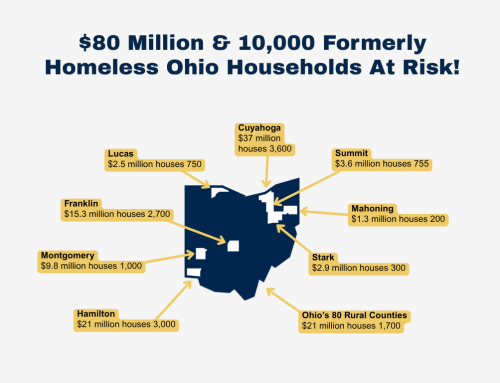FOR IMMEDIATE RELEASE: July 13, 2023
Housing advocates highlighted new state data released this week that shows how housing insecurity has escalated in Ohio since the pandemic.
The Ohio Housing Finance Agency’s new 2023 Ohio Housing Needs Assessment shows that more than 1 million Ohioans live in households that are spend over half their income on housing costs. This includes 707,820 renters and 325,722 homeowners.
Amy Riegel, executive director of the Coalition on Homelessness and Housing in Ohio, said the fact that so many Ohioans are spending most of their income to pay their rent or mortgage means a significant portion of the state’s workforce is living in constant risk of eviction and homelessness.
“People need a safe, decent, affordable home to live to raise families, go to school, hold down a job, or age in place,” Riegel said. “Expanding access to affordable housing is a prerequisite for Ohio’s future prosperity.”
Other concerning data in the new Housing Needs Assessment include:
- In 2021, 25 percent of all Ohio renters were spending at least half their income on housing, up from a record low of 23 percent in 2019.
- There are 447,717 extremely low-income (ELI) renters in Ohio, but only 177,318 rental homes affordable and available to them, leaving a shortage of 270,399 units.
- After years of gradually shrinking, this affordability gap between supply and demand for the lowest-income renters is now widening, with a net loss of over 15,000 affordable units between 2020 and 2021.
- Rent is now higher than in any year on record other than 2021, even when adjusted for inflation.
- Eviction proceedings affected 6.4 percent of Ohio’s tenants in 2022 and returned to near pre-pandemic levels after decreasing to 4.2 percent in 2020 due to the eviction moratorium and emergency rental assistance.
OHFA’s Housing Needs Assessment comes shortly after Gov. DeWine signed the biennial budget bill, which creates a new state housing tax credit program that is expected to produce an estimated 4,000 affordable rental units.
“We commend the governor and legislature for taking the first step toward addressing housing insecurity in the new budget,” Riegel said. “But this report shows we still have a long way to go to create stable housing for families, seniors, and people with disabilities who are spending over half their income on rent. We look forward to working with state leaders to plot a future where all children in Ohio have a safe, stable place to call home.”
-30-








